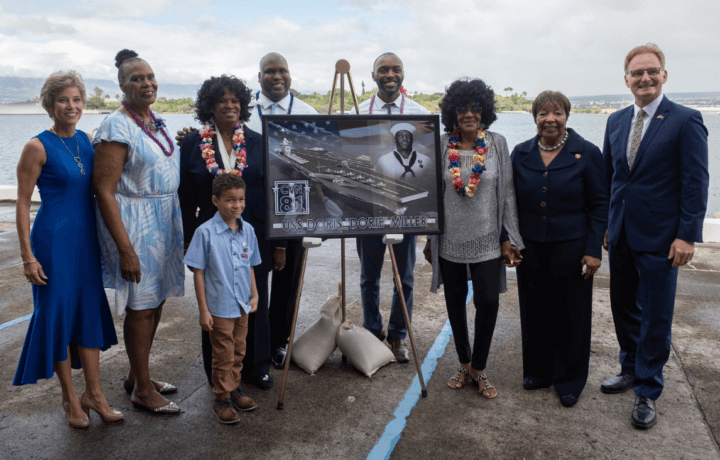Today, the United States Navy operates 11 aircraft carriers; a ship type Henry Kissinger had called “100,000 tons of diplomacy.” A lot of thought has gone into the naming of the carriers, and that is why eight of the current carriers are named after former Presidents of the United States of America. The most recent of the carriers is the lead ship of the Gerald R. Ford-class of supercarriers – named for the late President Gerald Ford, who served in the Navy during the Second World War.
The USS John F. Kennedy (CVN-79) will be the next carrier to enter the fleet. She was launched in 2019 and is scheduled to be commissioned in 2022, while the latest USS Enterprise (CVN-80) is under construction and could be commissioned in 2027.
The next U.S. Navy carrier ordered is the USS Doris Miller (CVN-81), which is scheduled to be laid down in 2026 and launched in October 2029. While it will be well over a decade until the carrier is commissioned and at least another five years before she enters service the warship is already notable for its naming.
CVN-81 will be the first carrier named for an enlisted sailor and the first to be named for an African American.
Who Was Doris Miller
Known as “Dorie” to his friends, Miller was one of the first American heroes of the Second World War. He was a cook but also the boxing champion on the USS West Virginia, and on the morning of December 7, 1941 he was below decks cleaning up breakfast when the Japanese sneak attack on Pearl Harbor began.
When the alarm bells sounded out for “Battle Stations,” Miller sprang into action and helped move the warship’s wounded captain Mervyn Bennion to a spot of safety behind a conning tower. Miller then manned a Browning .50 caliber anti-aircraft machine gun on the conning tower. While unfamiliar with the weapon, and untrained to operate it due to the Navy’s segregated policies, which kept African Americans from combat positions, Miller quickly figured it out and aimed at the attacking Japanese aircraft.
“It wasn’t hard,” Miller reportedly said of firing the weapon. “I just pulled the trigger and she worked fine. I had watched the others with these guns. I guess I fired her for about fifteen minutes. I think I got one of those Jap planes. They were diving pretty close to us.”
Even after orders were given to abandon ship, Miller remained on duty and helped evacuate shipmates and later saved the lives of his fellow sailors in the burning water. His actions on December 7 were fictionalized in the 2001 Michael Bay film Pearl Harbor with Miller portrayed by Cuba Gooding Jr.
The real life Miller was awarded the Navy Cross by Adm. Chester Nimitz, and later, he returned to duty on the USS Indianapolis and later on the USS Liscome Bay. He was aboard the latter warship when it was struck by a torpedo on November 24, 1943, off the Butaritari Atoll in the Gilbert Islands. While there were 272 survivors from the crew of more than 900, Miller was not among those rescued. His parents were notified he was missing in action two years after his heroic actions at Pearl Harbor.
His body was never found, but his name has graced schools, roads, and community centers across the United States. He could soon have equal footing with past presidents when CVN-81 is launched in nine years.
Presidential Names
There have been 34 vessels named for Presidents and currently only two Navy vessels that are not carriers are named for Presidents. Those include the USS Jimmy Carter (SSN-23), the third and final Seawolf-class, nuclear-powered, fast-attack submarine. It was named for President Carter as he was the only president to have qualified in submarines and today the boat bearing his name is only the third sub to be named for a living person and the only one to be named for a living president.
The USS Lyndon B. Johnson (DDG-1002) is the third and final Zumwalt-class destroyer, and she was christened in April 2019 and is scheduled to enter service in 2022. The Arleigh Burke-class destroyer USS Roosevelt (DDG-80) is technically named for both former President Franklyn Roosevelt and First Lady Eleanor Roosevelt.
Among those not named for a president include one named for Adm. Chester W. Nimitz, who was the navy’s third fleet admiral and Pacific fleet commander during the Second World War, while another is named for Rep. Carl Vinson, who was for 29 years the chairman of the House Naval Affairs and Armed Services Committee, and who has become known as the father of the two ocean navy.
Only the carrier named for Senator John C. Stennis of Mississippi lacks any substantive connection to the Navy other than being the first chairman of the Senate Armed Services Committee, during which time some major Naval Aviation programs took place. The naming of the carrier has become controversial not just for that fact but also because as a senator Stennis had fought against civil rights. Earlier this year there were even calls for the carrier, CVN-74, to be renamed.
In June, Lieutenant Commander Reuben Keith Green, U.S. Navy (Retired) even questioned the optics of the USS Doris Miller and USS John C. Stennis operating together.




